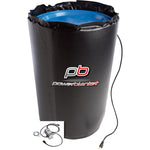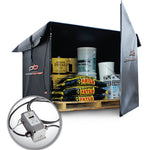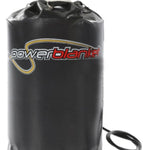You have no items in your shopping cart.
Warm Your Pipes with Heat Trace Insulation Solutions
Cold weather getting you down? This article will help you see the difference insulated heat trace can make when faced with frozen pipes and iced-over valves.
Article At-a-Glance
How Does Heat Trace Insulation Work and Why Is It Essential?
Heat trace insulation combines heating cables with insulating materials to efficiently maintain or regulate pipe temperatures, preventing freezing and minimizing heat loss, which is crucial for ensuring consistent fluid flow and energy efficiency in industrial and commercial applications.
Key Takeaways
- Understand the Basics: Heat trace insulation combines heating cables with insulating materials to prevent freezing and minimize heat loss, ensuring efficient temperature regulation in pipes and equipment.
- Key Components: A typical system includes heating cables, insulation materials like fiberglass or mineral wool, and control units such as thermostats to maintain desired temperatures.
- Installation Best Practices: Proper installation is crucial; match heating cable wattage to pipe size, consider ambient conditions, and use qualified personnel for complex systems.
- Applications and Benefits: Ideal for freeze protection, temperature maintenance in industrial processes, and preventing ice dams on roofs, heat trace systems enhance energy efficiency and reduce operational costs.
- Customization and Product Selection: Choose from various heating cables and insulation types, or opt for custom solutions tailored to specific industrial needs, ensuring compatibility with different fluids and environmental conditions.
Keeping Your Pipes Warm: A Guide to Heat Trace Insulation
Heat trace insulation is a reliable and efficient method for maintaining pipe temperature in various applications. It provides protection against freezing and ensures consistent flow of fluids, making it essential in plumbing systems exposed to cold environments or requiring specific temperature control.

What is Heat Tracing Insulation?
Heat tracing is an electrical heating system specifically designed for pipes and vessels. It utilizes a heating cable, which runs along the pipe's exterior, generating heat as electricity passes through it. This heat then transfers to the pipe itself, preventing the contents from freezing or maintaining a desired temperature.
Heat trace insulation systems typically consist of three key components:
- Heating Cable: This is the core element, responsible for generating heat. Heating cables come in various types, with self-regulating cables adjusting their output based on the surrounding temperature and constant wattage cables providing consistent heat.
- Insulation: After the heating cable is secured to the pipe, a layer of insulation is applied. This essential layer minimizes heat loss to the environment, ensuring the system operates efficiently and directing heat towards the pipe. Common insulation materials include fiberglass, mineral wool, and elastomeric foam.
- Controls: Thermostats or controllers regulate the heating cable's operation. These components can be pre-set to maintain a specific temperature or utilize sensors to automatically adjust heat output based on ambient conditions.

Benefits of a Heat Tracing System
Heat trace insulation offers a multitude of advantages. In cold weather, heat trace systems safeguard pipes from freezing and potential bursting. This is particularly crucial for outdoor pipes, uninsulated crawlspaces, or areas susceptible to freezing temperatures.
More Than Just Wire and Padding
Heat trace insulation is not limited to freeze protection. It can also maintain consistent fluid temperatures within a pipe, which is critical for processes requiring specific temperature ranges. This ensures optimal flow characteristics and prevents issues like solidification or increased viscosity.
Heat trace also improves energy efficiency within your process heating system. A well-designed insulated heat trace layout, with proper insulation thickness and controls, minimizes heat loss to the environment. This translates to lower energy consumption and operational costs.
Heat trace can also save money in two other ways: customization and removability. Offering a high degree of customization, heating cables come in various lengths and wattages to suit specific pipe sizes and needs. Additionally, the entire system can be dismantled relatively quickly if necessary, making it adaptable for temporary or changing requirements.
Choosing the Right Heat Trace Insulation
Selecting the appropriate heat trace insulation system requires careful consideration of several factors:
- Matching Heat Output to Pipe Size: The heating cable's wattage output needs to be matched to the pipe diameter. Insufficient wattage may not adequately heat the pipe, while excessive wattage can lead to overheating and damage the system or the pipe itself.
- Accounting for Ambient Temperature: The surrounding environment plays a crucial role. Outdoor pipes exposed to harsh winters will require a different heating cable setup compared to indoor pipes in a controlled temperature setting. Similarly, extreme cold climates necessitate a more robust system than moderate weather regions.
- Other Considerations: The type of fluid flowing through the pipe also influences the choice of heat trace system. For instance, highly viscous liquids may require a higher heat output to maintain flow compared to water. Additionally, consider whether the application involves continuous or intermittent operation, as this can affect the type of control system needed.
Heat Trace Insulation Applications
Heat trace insulation finds application in a wide range of industries and scenarios. Here are three common examples of how professionals use insulated heat trace:
- Freeze Protection for Pipes: Protecting outdoor pipes, water lines in uninsulated areas, fire sprinkler systems, and pipes in cold storage facilities.
- Temperature Maintenance Systems: Maintaining optimal temperatures for process liquids in industrial plants, preventing solidification of oils or chemicals, and ensuring consistent hot water flow in domestic applications.
- Roofing and Guttering Systems: Preventing ice dams on roofs and gutters, which can cause water damage to buildings.
Custom Heat Tracing Solutions
Not all applications are suitable for off-the-shelf heat trace products. For intricate piping layouts, unique installations, or remote locations, custom heat trace control options can be designed by qualified engineers. These solutions often involve specialized heating cables and control systems tailored to meet specific project requirements.
Heat Trace Insulation for Chemicals
Custom heat trace solutions are also helpful when dealing with corrosive or volatile substances. Maintaining the right temperature for proper viscosity and flow of these chemicals is crucial in many industrial processes. Heat trace systems can be designed to handle various chemicals, with special considerations for compatibility with potentially corrosive fluids or other dangerous substances.
Other pipe heating options are also reliant on heat trace, though how the cables are used can vary depending on the product.

Heat tape, a form of heat trace, is an uninsulated component of process heating.
Installing Your Heat Tracing System
Proper installation of the heat trace system is essential for optimal performance and safety. Always refer to the manufacturer's guidelines for specific installation procedures. Key aspects include:
- Selecting the appropriate insulation thickness based on pipe size and ambient conditions.
- Utilizing qualified personnel for installation, particularly for complex systems.
- Employing control panels to regulate heat output and maximize energy efficiency.
For a more detailed guide on heat trace installation, visit our other article on heat trace: “Heat Trace Explained.”
Trusted Heat Trace Brands
Several reputable brands manufacture high-quality heat trace insulation systems. Powerblanket, for example, makes heat trace equipment suited for the most rugged environments. Thermon also is a global leader in heat trace products.
Explore options with companies like Powerblanket or consult with a qualified distributor to find the ideal heat trace insulation system for your application. You can also find a wider collection of pipe heating products from various brands through online marketplaces or electrical supply stores.
The Best in Freeze Protection… and Everything Else
No two heat trace applications are exactly the same. That's why we offer fully customizable heat trace solutions to meet your unique needs. From custom circuit lengths and power outputs to custom controls and sensors, we can design a heat trace system tailored specifically for your pipes, valves, vessels, and instruments.
No two heat trace applications are exactly the same. That’s why we offer fully customizable heat trace solutions to meet your unique needs. Get a Free Custom Heat Trace Consultation.













